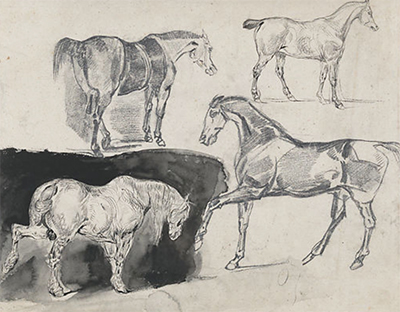Delacroix worked hard in all aspects of his technical work, but particularly with his portraiture and figurative work, be it for humans or animals. Here we find a series of studies of horses, an animal which features regularly across his career.
He completed sketches on both sides of this piece of paper, and perhaps it was originally a part of a sketchbook that the artist might have carried around within him. This theory is backed up by the dimensions of the paper, which roughly match what one might expect if that were to be the case. We refer to the front and back as the recto and verso, and on the reverse we find Four Studies of Galloping Horses and Riders. He would depict horses within his career as both static and animated, depending on the context, and these beautiful creatures were also used by a number of other Romanticist artists, as shown in Gericault's The Charging Chasseur and The Wounded Cuirassier. The whole movement was committed to the wildness of nature and this offered many avenues of creative expression for this groundbreaking set of (predominantly French) artists.
On the recto side, which is displayed here, we find four different sketches of horses, one of which is actually placed upon a darker background in order to practice contrast. Each of these drawings is from a slightly different angle as Delacroix looks into the muscular structure of these fine animals. He does not concern himself with movement here, nor with any additional items such as battle clothing or riders. Graphite is used here, along with some touches of pen although the image is not perhaps clear enough to spot them separately. We do know that Delacroix would travel to zoos in order to study the more exotic creatures that appear in his work, such as tigers and lions, but would certainly have found horses easier to come by in 19th century France.
"...I really must settle down seriously to drawing horses. I shall go to some stable or other every morning..."
This particular piece is dated at 1824-1825. Delacroix's close friend, Gericault, was actually a skilled horseman as well as being a fellow Romanticist artist, and so there was a clear connection here between artist and animal. We see this frequently across art history, where hobbies and interests become inspiration for artistic content, such as with Joaquín Sorolla (The Gardens at the Sorolla Family House) and Gustave Caillebotte (The Garden at Petit Gennevilliers and Les Orangers) who were keen gardeners and who then translated these topics into their work. Delacroix would have to produce some of his animation from memory, having seen horses in full flow from time to time. His series of Orientalist paintings would feature these animals regularly and he took great inspriration from English poet Lord Byron for some of the themes that he covered. He would also travel to the UK in order to study English literature in greater detail, as well as meeting and collaborating with some of the finest painters of the time based here.




